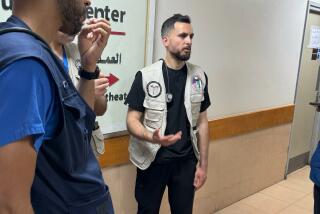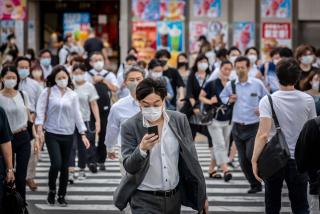Above the Call of Duty : Local Doctor Aids Ailing Passengers on Flight From Tokyo
- Share via
MISSION VIEJO — Dr. Naji Saied had flown to Beijing with a mission: to help a gravely ill friend get to the United States for medical treatment. But after a week of stonewalling by authorities, he left China dejected and frustrated.
In a twist of fate, the 51-year-old doctor found himself helping two strangers, one of them near death, who were overcome by illness on his flight home Wednesday from Tokyo to Los Angeles.
“There was a reason why I went, and maybe the purpose was not to help my friend in China,” said Saied, who lives in Dana Point and practices medicine in Mission Viejo. “By a sheer twist of mysterious fate or destiny, I was supposed to be on this flight.”
Saied only boarded the Northwest Airlines 747 because of a string of disrupted travel arrangements that rerouted him first to Hong Kong and left him weary and eager to sleep his way across the ocean.
Instead, two hours out of Tokyo, he found himself staring at a paltry emergency kit, searching for a stranger’s vein with a makeshift IV and struggling to monitor the man’s pulse over the roar and shake of the jet.
The 51-year-old man, a Japanese clerk who had saved money for years for his first trip to visit family in the United States, had celebrated by drinking two whiskeys and a glass of wine, a much higher dose of alcohol than he was accustomed to, Saied said. He collapsed outside the restroom door.
The Japanese man suffered from hypertension and was on medication for high blood pressure.
“His blood pressure was down to zero, and his pulse was barely perceptible,” Saied said. “He was hardly breathing. It looked like he was going to go downhill very fast.”
The airliner’s emergency kit contained some large needles, three small vials of dextrose and water, and a tourniquet. Saied managed to jam the too-large needle into a vein long enough to drip in the dextrose and raise his patient’s blood pressure.
By the time the plane circled Los Angeles International Airport, the man was stabilized. But another passenger collapsed in severe abdominal pain.
“The [flight attendant] comes and grabs me away and says, ‘Come on, there’s another emergency in the back of the plane,’ ” Saied said. “This young Vietnamese lady was sprawled out on the floor, and her brother was trying to help her, massaging her chest.” Her symptoms might have signaled a ruptured appendix, Saied said.
Through it all, Saied said, he was struck by the luck that placed him on board. Without his medical skills, and the help of a New Zealand passenger who assisted the doctor, the Japanese man probably would have died, Saied said.
Saied exchanged business cards with the pilot and co-pilot as well as the man he had saved, who was taken to a local hospital. The woman, a 22-year-old Vietnamese immigrant, spoke no English, and Saied did not learn her name before immigration officials took her off the plane in a wheelchair.
“I really think the public should be aware that if these emergencies happen, the airline should have better equipment,” he said. “You need the basic resuscitative equipment, because this could happen to anybody. It can really make a difference between life and death.”
A Northwest Airlines spokesman in Minneapolis confirmed that the medical emergencies occurred on the flight but said details were not available.
Airlines say there are limits to what they can do to prepare for in-flight medical emergencies. Most airliners do not carry emergency equipment such as defibrillators, sometimes critical to restarting a patient’s failing heart. Instead, most can only offer an emergency medical kit stocked with basic items such as a stethoscope, syringes and nitroglycerin tablets.
As Saied waited to pick up his luggage in the airport terminal Wednesday, the wife of his first in-flight patient “saw me standing in line, and she came over with someone who looked like her sister,” he said. “They both bowed several times to me, in the Japanese style. I really felt like crying.”
More to Read
Sign up for Essential California
The most important California stories and recommendations in your inbox every morning.
You may occasionally receive promotional content from the Los Angeles Times.














